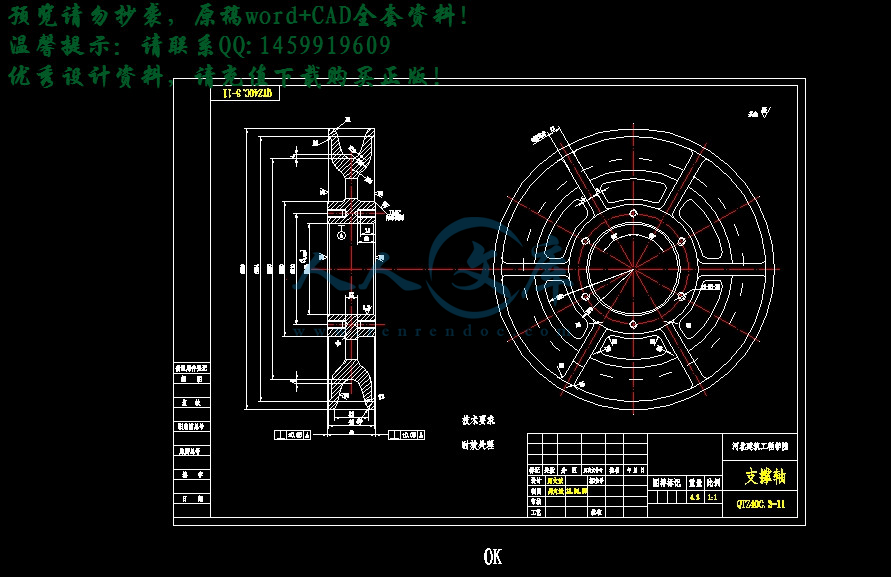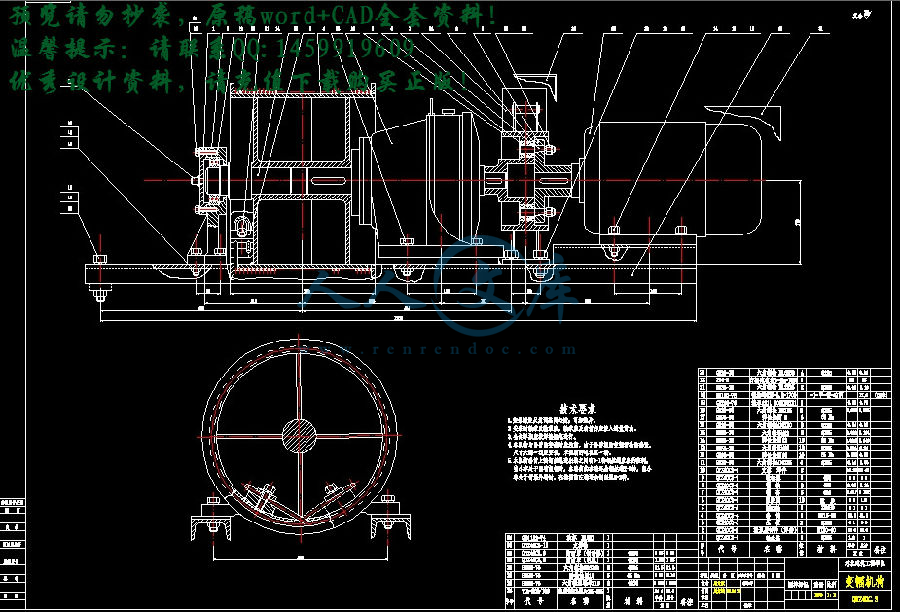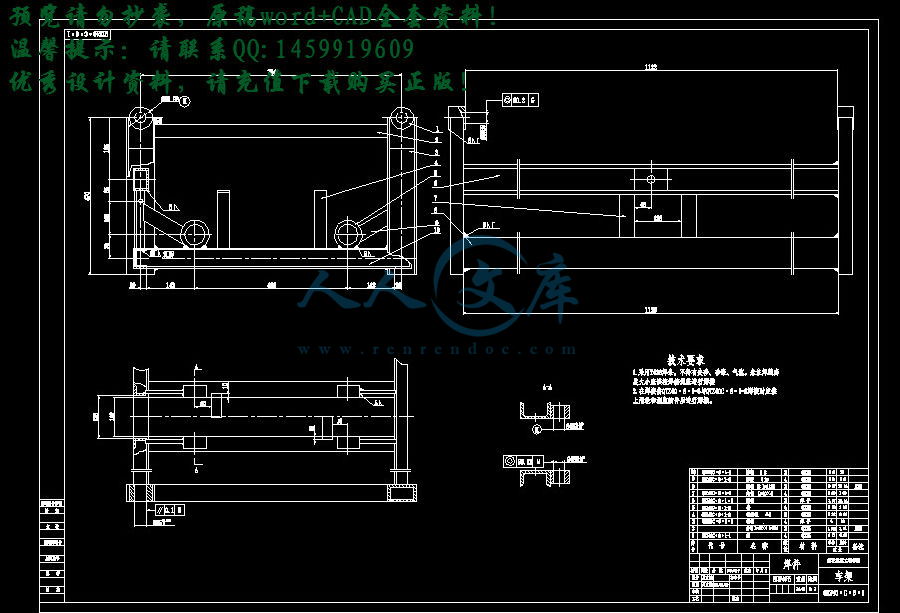QTZ40塔式起重机总体及变幅机构的设计
QTZ40塔式起重机——变幅系统的设计
QTZ40塔式起重机的变幅系统设计【优秀机械毕业设计】【word+50张CAD图纸全套】
【带任务书+开题报告+外文翻译+实习报告】【73页@正文35260字】【详情如下】【全套设计需要咨询请加QQ1459919609】.bat
图纸总汇50张.dwg
实习报告.doc
封皮.docx
我的开题报告.doc
摘要.docx
正文.docx
目录.docx
翻译原文.pdf
英语翻译.doc
设计任务书.doc
毕业设计(论文)任务书
QTZ40塔式起重机——变幅系统的设计
1、毕业设计(论文)目的:
本次毕业设计是对机械专业学生在毕业前的一次全面训练,目的在于巩固和扩大学生在校所学的基础知识和专业知识,训练学生综合运用所学知识分析和解决问题的能力。是培养、锻炼学生独立工作能力和创新精神的最佳手段。毕业设计要求每个学生在工作过程中,要独立思考,刻苦钻研,有所创新、解决相关技术问题。通过毕业设计,使学生掌握塔式起重机的总体设计、变幅机构的设计、变幅小车的设计和计算等内容,为今后步入社会、走上工作岗位打下良好的基础。
2、毕业设计(论文)任务内容和要求(包括原始数据、技术要求、工作要求等):
(1)设计任务:
①总体参数的选择(QTZ40级别)
②结构形式
(2)总体设计
①主要技术参数性能
②设计原则
③平衡重的计算
④塔机的风力计算
⑤整机倾翻稳定性的计算
(3)变幅机构的设计和计算
①变幅机构的形式
②确定卷筒尺寸
③选择电动机、减速器、制动器、联轴器
④验算实际变幅速度
⑤验算起、制动时间
⑥电动机发热验算
⑦卷筒强度的计算
(4) 变幅小车的设计
① 变幅小车的形式
② 变幅小车的强度计算
(5) 设计要求
① 主要任务:学生应在指导教师指导下独立完成一项给定的设计任务,编写符合要求的设计说明书,并正确绘制机械与电气工程图纸,独立撰写一分毕业论文,并绘制有关图表。
② 知识要求:学生在毕业设计工作中,应综合运用多学科的理论、知识与技能,分析与解决工程问题。通过学习、钻研与实践,深化理论认识、扩展知识领域、延伸专业技能。
③ 能力培养要求:学生应学会依据技术课题任务,完成资料的调研、收集、加工与整理,正确使用工具书;培养学生掌握有关工程设计的程序、方法与技术规范,提高工程设计计算、图纸绘制、编写技术文件的能力;培养学生掌握实验、测试等科学研究的基本方法;锻炼学生分析与解决工程实际问题的能力。
④ 综合素质要求:通过毕业设计,学生应掌握正确的设计思想;培养学生严肃认真的科学态度和严谨求实的工作作风;在工程设计中,应能树立正确的生产观、经济观与全局观。
⑤ 设计成果要求:
1)凡给定的设计内容,包括说明书、计算书、图纸等必须完整,不得有未完的部分,不应出现缺页、少图纸现象。
2)对设计的全部内容,包括设计计算、机械构造、工作原理、整机布置等,均有清晰的了解。对设计过程、计算步骤有明确的概念,能用图纸完整的表达机械结构与工艺要求,有比较熟练的认识图纸能力。对运输、安装、使用等亦有一般了解。
3)说明书、计算书内容要精练,表述要清楚,取材合理,取值合适,设计计算步骤正确,数学计算准确,各项说明要有依据,插图、表格及字迹均应工整、清楚、不得随意涂改。制图要符合机械机械制图标准,且清洁整齐。
4)对国内外塔式起重机情况有一般的了解,对各种塔式起重机有一定的分析、比较能力。
其他各项应符合本资料有关部分提出的要求。
3、毕业设计(论文)成果要求(包括图表、实物等硬件要求):
① 计算说明书一份
内容包括:设计任务要求的选型、设计计算内容、毕业实习报告等。作到内容完整,论证充分(包括经济性论证),字迹清楚,插图和表格正规(分别进行统一编号)、批准,字数要求不少于2万字;撰写中英文摘要;提倡学生应用计算机进行设计、计算与绘图。
② 图纸一套
不少于四张零号图纸量
4、主要参考文献:
【1】 董刚 李建功 潘风章主编 《机械设计》(第3版) 北京:机械工业出版社 1998
【2】 张质文,虞和谦等.起重机设计手册.北京:中国铁道出版社.1997.
【3】 《机械设计手册》(第1卷)(新版)机械设计手册编委会编著
北京:机械工业出版社 2004.8
【4】 《机械设计手册》(第2卷)(新版)机械设计手册编委会编著
北京:机械工业出版社 2004.8
【5】 成大先主编《机械设计手册》(第4版)北京:化学工业出版社 2002
【6】 顾迪民主编《工程起重机》(第2版)北京:中国建筑工业出版社 1988
【7】 刘品主编《互换性与测量技术基础》(第2版)哈尔滨:哈尔滨工业大学出版社 2001
【8】 徐灏主编《机械设计手册》(第2版) 北京:机械工业出版社 2000
【9】 曹双寅主编《工程结构设计原理》 南京:东南大学出版社 2002
【10】刘鸿文主编《材料力学》(第4版) 高等教育出版社
【11】《QTZ400塔式起重机使用说明书》
【12】张青 张瑞军 编著《工程起重机结构与设计》北京:化学工业出版社,2008.7
【13】中华人民共和国国家标准GB/T 13752-92 《塔式起重机设计规范》 北京:中国标准出版社 1993
【14】范俊祥主编《塔式起重机》 中国建材工业出版社
【15】许镇宇、邱宣怀主编:《机械零件》 人民教育出版社
【16】刘佩衡主编《塔式起重机使用手册》 北京:机械工业出版社,2002
【17】中国建设部《钢结构设计规范》 2003.12
【18】黄靖远 龚剑霞 贾延林 《机械设计学》北京工业出版社,2002
【19】safety on construction sites 著者American Society of civil Engineers.Task Committee on Crane Safety on Constructions Sites 中图分类号:TH21-36
【20】孙在鲁 著《塔式起重机应用技术》北京:中国建材工业出版社,2003.5
【21】SAE crane standards manual 著者Backham 中图分类号:TH21-65
5、毕业设计(论文)课题工作进度计划:
起 迄 日 期工 作 内 容
2013.3.25-2013.3.28
2013.3.29-2013.4.13
2013.4.14-2013.4.20
2013.4.21-2013.5.15
2013.5.16-2013.6.5
2013.6.6-2013.6.19
2013.6.20-2013.6.21
熟悉整理资料
方案选择及总体设计
绘制总图
变幅机构、变幅小车的设计
绘制变幅机构、变幅小车装配图
绘制零件图纸
准备论文及答辩
摘要
塔式起重机作为建筑施工的主要设备,在建筑等行业发挥着极其重要的作用。塔式起重机属于臂架型起重机,由于其臂架铰接在较高的塔身上,且可回转,臂架长度较大,结构轻巧、安装拆卸运输方便,适于露天作业,因此大多数用于工业与民用建筑施工。
塔式起重机是为了满足高层建筑施工、设备安装而设计的新型起重运输机械,QTZ40塔式起重机是由建设部长沙建设机械研究院设计的新型建筑用塔式起重机,该机为水平臂架,小车变幅,上回转自升式多用途塔机。
本设计的题目是固定式QTZ40塔式起重机起升系统的设计。QTZ40塔式起重机有多种形式,此次设计的形式为上回转液压顶升自动加节,可随着建筑物的升高而升高,固定式高度为30米,在附着状态下可达到100米,其工作幅度为40米。
本设计书主要包括三部分:第一部分是QTZ40塔式起重机总体方案的选择及总体设计计算过程;第二部分是变幅机构的设计与计算:包括变幅机构的形式、确定卷筒尺寸、选择电动机、减速器、制动器、联轴器;验算实际变幅速度 验算起、制动时间;电动机发热验算;卷筒强度的计算;第三部分是变幅小车的设计:包括变幅小车的形式、变幅小车的强度计算。
关键词:QTZ40塔式起重机 总体设计:变幅系统
ABSTRACT
As an important facility, the tower crane plays an important role in construction industry. The tower crane belongs to the arm rack type crane. Its arm is hinged on the high tower body, and it may rotate. It has longer arm, dexterous structure. What’s more, it is easy to be assembled, disassembled and transported. It is suitable for the open-air work and mainly used for industry and civil construction
Tower cranes are to meet high-rise construction building, equipment installation and design as a new type machinery of lifting transport. The QTZ40 tower cranes are new tower cranes designed by Changsha Institute of the Ministry of Construction Machinery used in construction building. The aircraft is horizontal boom, trolley luffing, on the back or decanted from the tower-type multi-purpose machines .
The design topic is the stationary QTZ40 tower crane system and the design of lifting structure. There are many kinds of QTZ40 tower crane. The form of this design is as below. With an upper rotating hydraulic pressure propping system, the machine could add height automatically and thus rise with the building ascension. The stationary type is 30meter high; it could reach the height of 100meters when it is being adhered. Its work scope is 40 meters.
This design book mainly includes three parts. The first part summarizes the present situation and the development tendency of the tower crane in both our country and abroad, as well as the characteristic and application occasion..The second part is the QTZ40 tower crane overall concept choice and the system design computation process; the third part is the organization design and the computation of lifting mechanism and the last is the design of the hook group.
Keywords: QTZ500 tower crane The total design:luffing system
目录
第1章 前言1
1.1塔式起重机概述1
1.2塔式起重机的发展趋势1
第2章 总体设计2
2.1 概述2
2.2确定总体设计方案2
2.2.1 选择确定总体参数 2
2.2.2工作机构20
2.2.3安全保护装置28
2.3 总体设计设计总则30
2.3.1 整体工作级别30
2.3.2 机构工作级别30
2.3.3 主要技术性能参数31
2.4 平衡重的计算31
2.5 起重特性曲线33
2.6 塔机风力计算35
2.6.1工作工况Ⅰ35
2.6.2工作工况Ⅱ 39
2.6.3非工作工况Ⅲ41
2.7 整机的抗倾覆稳定性计算44
2.7.1工作工况Ⅰ45
2.7.2工作工况Ⅱ 46
2.7.3非工作工况Ⅲ47
2.7.3非工作工况Ⅳ48
2.8 固定基础稳定性计算49
第3章 变幅机构的设计和计算 51
3.1变幅机构的形式 51
3.2 确定卷筒的尺寸51
3.2.1 卷筒的名义直径51
3.2.2 多层绕卷筒相关参数计算52
3.3. 选择电动机、减速器、制动器、联轴器53
3.3.1选择电动机 53
3.3.2 选择减速器 54
3.3.3 变幅机构制动器的选择54
3.3.4变幅机构联轴器的选择 55
3.4. 验算变幅速度57
3.5验算起、制动时间验算 57
3.6电动机发热校验 59
3.7 校验卷筒强度60
第4章 变幅小车的设计61
4.1 变幅小车的形式61
4.2 变幅小车的设计61
4.2.1绳索牵引式小车构造及其驱动方式61
4.2.2 运行小车牵引力计算63
4.2.3牵引绳最大张力66
4.2.4 选择牵引绳67
4.2.5 牵引卷筒计算67
毕业设计小结70
参考文献 72
第1章 前言
1.1 概述
塔式起重机是我们建筑机械的关键设备,在建筑施工中起着重要作用,我们只用了五十年时间走完了国外发达国家上百年塔机发展的路程,如今已达到发达国家九十年代末期水平并跻身于当代国际市场。
QTZ40型塔式起重机简称QTZ40型塔机,是一种结构合理,性能比较优异的产品,比较国内同规格同类型的塔机具有更多的优点,能够满足高层建筑施工的需要,可用于建筑材料和预制构件的吊运和安装,并能在市内狭窄地区和丘陵地带建筑施工。高层建筑施工中,它的幅度利用率比其他类型起重机高,其幅度利用率可达全幅度的80%。
QTZ40型塔式起重机是400kN·m上回转自升式塔机。上回转自升塔式起重机是我国目前建筑工程中使用最广泛的塔机,几乎是万能塔机。它的最大特点是可以架得很高,所以所有的高层和超高层建筑、桥梁工程、电力工程,都可以用它去完成。这种塔式起重机适应性很强,所以市场需求很大。
1.2 发展趋势
塔式起重机是在第二次世界大战后才真正获得发展的。在六十年代,由于高层、超高层建筑的发展,广泛使用了内部爬升式和外部附着式塔式起重机。并在工作机构中采用了比较先进的技术,如可控硅调速、涡流制动器等。进入七十年代后,它的服务对象更为广泛。因此,幅度、起重量和起升高度均有了显著的提高。
就工程起重机而言,今后的发展主要表现在如下几个方面:①整机性能:由于先进技术和材料的应用,同种型号的产品,整机重量要轻20%左右;②高性能、高可靠性的配套件,选择余地大、适应性好,性能得到充分发挥;③电液比例控制系统和智能控制显示系统的推广应用;④操作更方便、舒适、安全,保护装置更加完善;⑤向吊重量大、起升高度、幅度更大的大吨位方向发展。
第2章 总体设计
2.1 概述
总体设计是毕业设计中至关重要的一个环节,它是后续设计的基础和框架。只有在做好总体设计的前提下,才能更好的完成设计。它是对满足塔机技术参数及形式的总的构想,总体设计的成败关系到塔机的经济技术指标,直接决定了塔机设计的成败。
1.遵循“三化”:即零件标准化、产品系列化、部件通用化。
2.采用“四新”:即新技术、新结构、新材料、新工艺。
3.满足“三好”:即好制造、好使用、好维修。
制定设计总则以后,便可以编写设计任务书,在调研的基础上运用所学的知识,确定总体设计方案,保证设计的成功。
总体设计指导各个部件和各个机构的设计进行,一般由总工程师负责设计。在接受设计任务以后,应进行深入细致的调查研究,收集国内外的同类机械的有关资料,了解当前的国内外塔机的使用、生产、设计和科研的情况,并进行分析比较,制定总的设计原则。设计原则应当保证所设计的机型达到国家有关标准的同时,力求结构合理,技术先进,经济性好,工艺简单,工作可靠。
2.2 确定总体设计方案
QTZ40塔式起重机是上回转液压自升式起重机。尽管其设计型号有各种各样,但其基本结构大体相同。整台的上回转塔机主要由金属结构,工作机构,液压顶升系统,电器控制系统及安全保护装置等五大部分组成。
2.2.1 金属结构
塔式起重机金属结构部分由塔顶,吊臂,平衡臂,上、下支座,塔身,转台等主要部件组成。对于特殊的塔式起重机,由于构造上的差异,个别部件也会有所增减。金属结构是塔式起重机的骨架,承受塔机的自重载荷及工作时的各种外载荷,是塔式起重机的重要组成部分,其重量通常约占整机重量的一半以上,因此金属结构设计合理与否对减轻起重机自重,提高起重性能,节约钢材以及提高起重机的可靠性等都有重要意义。
1. 塔顶
自升塔式起重机塔身向上延伸的顶端是塔顶,又称塔帽或塔尖。其功能是承受臂架拉绳及平衡臂拉绳传来的上部载荷,并通过回转塔架、转台、承座等的结构部件或直接通过转台传递给塔身结构。
自升式塔机的塔顶有直立截锥柱式、前倾或后倾截锥柱式、人字架式及斜撑式等形式。截锥柱式塔尖实质上是一个转柱,由于构造上的一些原因,低部断面尺寸要比塔身断面尺寸为小,其主弦杆可视需要选用实心圆钢,厚壁无缝钢管或不等边角钢拼焊的矩形钢管。人字架式塔尖部件由一个平面型钢焊接桁架和两根定位系杆组成。而斜撑式塔尖则由一个平面型钢焊接桁架和两根定位系杆组成。这两种型式塔尖的共同特点是构造简单自重轻,加工容易,存放方便,拆卸运输便利。
塔顶高度与起重臂架承载能力有密切关系,一般取为臂架长度的1/7-1/10,长臂架应配用较高的塔尖。但是塔尖高度超过一定极限时,弦杆应力下降效果便不显著,过分加高塔尖高度不仅导致塔尖自重加大,而且会增加安装困难需要换用起重能力更大的辅助吊机。因此,设计时,应权衡各方面的条件选择适当的塔顶高度。
本设计采用前倾截锥柱式塔顶,断面尺寸为1.36m×1.36m。腹杆采用圆钢管。塔顶高6.115米。塔冒用无缝钢管焊接而成,顶部设有连接平衡臂拉杆和吊臂拉杆的铰销吊耳,以及穿绕起升钢丝绳的定滑轮,顶部应装有安全灯和避雷针。其结构如图2-1所示:
图2-1 塔顶结构图
2. 起重臂
1) 构造型式
塔式起重机的起重臂简称臂架或吊臂,按构造型式可分为:小车变幅水平臂架;俯仰变幅臂架,简称动臂;伸缩式小车变幅臂架;折曲式臂架。
小车变幅水平臂架,简称小车臂架,是一种承受压弯作用的水平臂架,是各式塔机广泛采用的一种吊臂。其优点是:吊臂可借助变幅小车沿臂架全长进行水平位移,并能平稳准确地进行安装就位。因此此次设计采用小车变幅水平臂架。
小车臂架可概分为三种不同型式:单吊点小车臂架,双吊点小车臂架和起重机与平衡臂架连成一体的锤头式小车臂架。单吊点小车变幅臂架是静定结构,而双吊点小车变幅臂架则是超静定结构。幅度在40m以下的小车臂架大都采用单吊点式构造;双吊点小车变幅臂架结构一般幅度都大于50m。双吊点小车变幅臂架结构自重轻,据分析与同等起重性能的单吊点小车变幅臂架相比,自重均可减轻5%-10%。小车变幅臂架拉索吊点可以设在下弦处,也可设在上弦处,现今通用小车变幅臂架多是上弦吊点,正三角形截面臂架。这种臂架的下弦杆上平面均用作小车运行轨道。
2) 分节问题
臂架型式的选定及构造细部处理取决于塔机作业特点,使用范围以及承载能力等因素,设计时,应通盘考虑作出最佳选择,首先要解决好分节问题。
小车臂架常用的标准节间长度有6、7、8、10、12m五种。为便于组合成若干不同长度的臂架,除标准节间外,一般都配设1~2个3~5m长的延接节,一个根部节,一个首部节和端头节。端头节构造应当简单轻巧,配有小车牵引绳换向滑轮、起升绳端头固定装置。此端头节长度不计入臂架总长,但可与任一标准节间配装,形成一个完整的起重臂。本次设计选用标准节长度为6m,另加上2m长的延接节。其示意图见图2-2:
图2-2臂架分节
3) 截面形式及截面尺度
塔机臂架的截面形式有三种:正三角形截面、倒三角形截面和矩形截面。小车变幅水平臂架大都采用正三角形截面,本次设计的QTZ40采用正三角形截面。选用这种方式的优点是:节省钢材,减轻重量,从而节约成本。其尺寸截面形式如图2-3所示:
图2-3 臂架截面及其腹杆布置
1-水平腹杆2-侧腹杆3-上弦杆4-下弦杆
臂架一-五节:B=1020mm H=800mm
臂架六-七节:B=1017mm H=800mm
臂架截面尺寸与臂架承载能力、臂架构造、塔顶高度及拉杆结构等因素有关。截面高度主要受最大起重量和拉杆吊点外悬臂长度影响最大。截面宽度主要与臂架全长有关。设计臂架长度为40m,共分七节。
4) 腹杆布置和杆件材料选用
矩形截面臂架的腹杆体系宜采用人字式布置方式,而三角形截面起重臂的腹杆体系既可采用人字式布置方式,也可 采用顺斜置式。此两种布置方式各有特点。
当采用顺斜置式式,焊缝长度较短、质量不易保证。焊接变形不均匀,节点刚度较差,且不便于布置小车变幅机构。因此本设计选用人字式布置方式。其优点在于,这种布置方式应用区段不受限制,焊缝长度较长,强度易于保证,焊接变形较均匀,节点刚度较好,便于布置小车变幅机构。
臂架杆件材料有多种选择可能性。一般情况下,上吊点小车变幅臂架的上弦以选用16Mn实心钢为宜,但造价要高。因此本设计选用20号无缝圆钢管。其特点是:惯性矩、长细比要小,抗失稳能力高。下弦采用等边角钢对焊的箱型截面杆件,经济实用,具有良好的抗压性能。因此上弦杆选用89×8、89×7,下弦选用的角钢型号为:75×8、75×5,臂间由销轴连接。
参考文献
【1】 董刚 李建功 潘风章主编 《机械设计》(第3版) 北京:机械工业出版社 1998
【2】 张质文,虞和谦等.起重机设计手册.北京:中国铁道出版社.1997.
【3】 《机械设计手册》(第1卷)(新版)机械设计手册编委会编著
北京:机械工业出版社 2004.8
【4】 《机械设计手册》(第2卷)(新版)机械设计手册编委会编著
北京:机械工业出版社 2004.8
【5】 成大先主编《机械设计手册》(第4版)北京:化学工业出版社 2002
【6】 顾迪民主编《工程起重机》(第2版)北京:中国建筑工业出版社 1988
【7】 刘品主编《互换性与测量技术基础》(第2版)哈尔滨:哈尔滨工业大学出版社 2001
【8】 徐灏主编《机械设计手册》(第2版) 北京:机械工业出版社 2000
【9】 曹双寅主编《工程结构设计原理》 南京:东南大学出版社 2002
【10】刘鸿文主编《材料力学》(第4版) 高等教育出版社
【11】《QTZ400塔式起重机使用说明书》
【12】张青 张瑞军 编著《工程起重机结构与设计》北京:化学工业出版社,2008.7
【13】中华人民共和国国家标准GB/T 13752-92 《塔式起重机设计规范》 北京:中国标准出版社 1993
【14】范俊祥主编《塔式起重机》 中国建材工业出版社
【15】许镇宇、邱宣怀主编:《机械零件》 人民教育出版社
【16】刘佩衡主编《塔式起重机使用手册》 北京:机械工业出版社,2002
【17】中国建设部《钢结构设计规范》 2003.12
【18】黄靖远 龚剑霞 贾延林 《机械设计学》北京工业出版社,2002
【19】safety on construction sites 著者American Society of civil Engineers.Task Committee on Crane Safety on Constructions Sites 中图分类号:TH21-36
【20】孙在鲁 著《塔式起重机应用技术》北京:中国建材工业出版社,2003.5
【21】SAE crane standards manual 著者Backham 中图分类号:TH21-65













 川公网安备: 51019002004831号
川公网安备: 51019002004831号